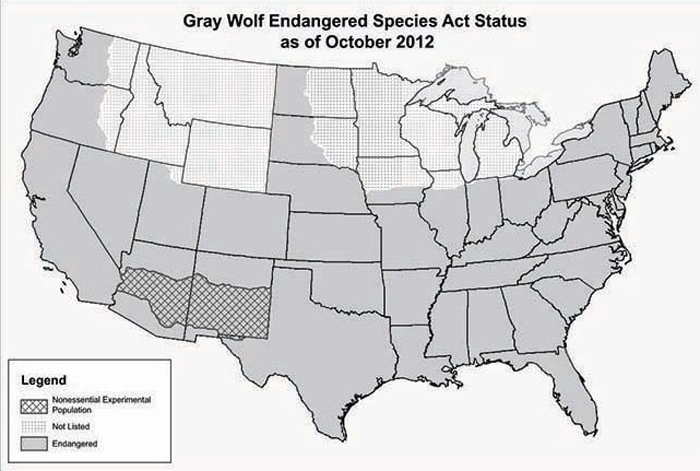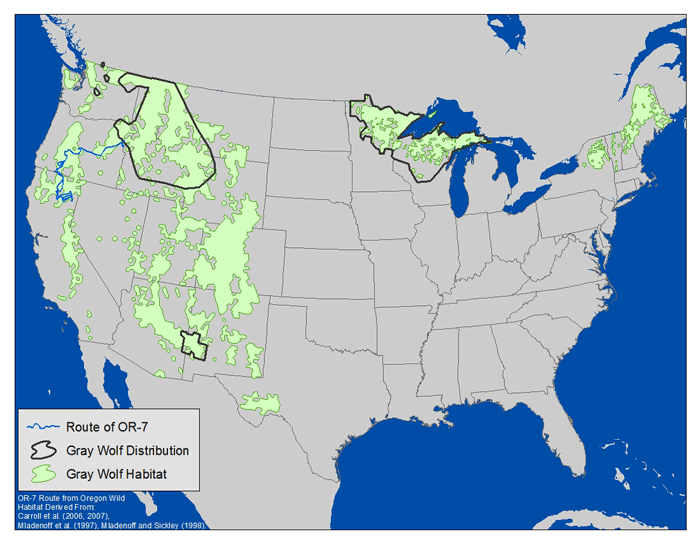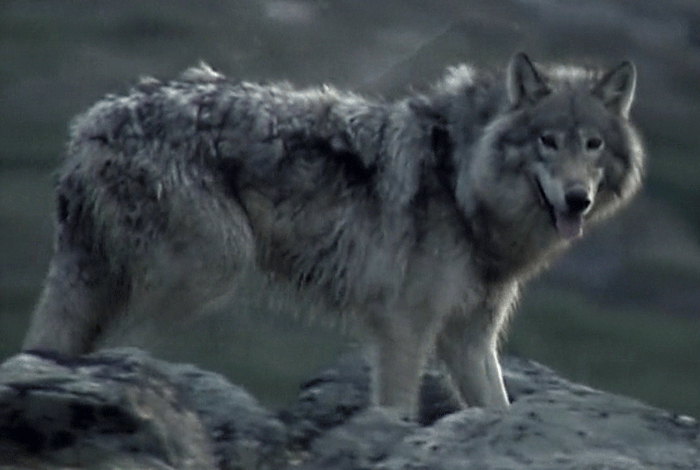The U.S. Fish & Wildlife Service (FWS) announced last summer that it was proposing a new rule to officially delist the gray wolf (Canis lupus) from protections under the Endangered Species Act (ESA). Public outcry has led the FWS to extend the public comment period until December 17, 2013.
Protect the Adirondacks opposes this proposal and recommends that the FWS continue to provide ESA protections for the gray wolf. See PROTECT comment letter.
The stakes are high for the Adirondack Park and Northeast U.S. with the FWS action to delist the gray wolf. If this action is approved, it will mean that for all practical purposes the gray wolf population in the U.S. will remain as it is today and not grow and expand, with viable populations constricted to the west, in the greater Yellowstone Park area, and the Upper Midwest. If a gray wolf population is ever to be established in the Adirondack Park, and our native ecosystem restored, federal protection under the ESA is essential.
In 2013, the gray wolf has established viable populations in the western U.S. in Idaho, Wyoming, and Montana, as well as with smaller populations in eastern Oregon and Washington. Gray wolves have also made a major comeback in the western Great Lakes states of Michigan, Wisconsin, and Minnesota, with smaller populations in the eastern Dakotas.
While the return of the gray wolf to parts of the American west and western Great Lakes states has been a major success story for the Endangered Species Act, these areas represent but a fraction of the total native habitat of the gray wolf in the continental U.S. Today, the FWS estimates that there are over 2,000 gray wolves in Minnesota, over 800 in Wisconsin, and over 600 in Michigan’s Upper Peninsula. Out west, estimates put the wolf populations at over 600 wolves in Idaho, over 600 in Montana, over 250 in Wyoming, and a handful in areas of eastern Washington and Oregon. The much-celebrated Yellowstone wolf restoration program has seen multiple packs develop with a total population of 100-150 wolves.
The FWS estimates there are 65,000 wolves in Canada and Alaska. Defenders of Wildlife published a good page on basic facts about gray wolves. The map below shows protections for gray wolves as it stands today under the Endangered Species Act.

The Endangered Species Act no longer protects gray wolves in areas of the west and Upper Midwest where viable populations have established. The proposed delisting rule would remove protections for wolves that established populations in other parts of the U.S.
Against this background of success, the FWS returned management of the gray wolf, under Congressional legislation, to the western and Upper Midwest states in 2012. Soon thereafter, most of these states out west started wolf hunting programs that have claimed over 500 wolves by March 2013. One of the most famous of the Yellowstone wolves, who was photographed widely, was shot outside the park in Wyoming.
A second piece of the FWS program for gray wolves is to now delist them from federal protection under the ESA. The thinking is that viable populations have returned to core historic habitats in upper Midwest and the western states. Given these population, the minimal criteria of the ESA have been fulfilled.
The FWS delisting proposal has been met with strong opposition. Many organizations and scientists have challenged the FWS proposal for a variety of reasons. The major arguments for why gray wolf-delisting is a bad idea are these.
There are many reasons that Protect the Adirondacks believes that the proposal to delist the gray wolf from ESA protections is a bad idea.
Two recoveries are successful, but just the beginning: The gray wolf has barely begun to recover or is absent from significant portions of its former range where substantial suitable habitat remains in the Western U.S., Midwest and Northeast. The established gray wolf populations in the West and Upper Midwest represent a small portion of overall gray wolf historic habitat. Why delist the gray wolf in states where it does not yet exist, unless the goal is to prevent new populations from being established in new locations?
The delisting action will likely negatively impact the establishment of viable populations in new areas of the West that have strong wolf habitat. Some of the best habitat in the U.S. for gray wolves is currently unoccupied, such as northern California, Colorado, and Utah. These are the areas most likely to see new wolf populations if ESA protections are sustained. The delisting rule will foreclose re-colonization of these areas by the gray wolf.
The FWS delisting rule fails to consider the importance of these new potential wolf habitat areas to the long-term survival and recovery of wolves, or the importance of wolves to the ecosystems of these regions. If the gray wolf is delisted, then it will be impossible for natural re-colonization of wolves in other parts of its historic range, such as the Northeast and Adirondack Park.

The map above shows current gray wolf population locations and areas where gray wolves historically occupied. OR-7 refers to a wolf that emigrated from Yellowstone to northern California and is now being tracked by California wildlife officials.
California wildlife officials are tracking the movements of “OR-7”, a 2.5 year old male gray wolf that left Yellowstone for northern California. Click here for a good site for up-to-date reports on the travels of OR-7.
Delisting is contrary to Endangered Species Act: The ESA calls for populations of protected species to be re-established to “a significant portion of its range.” Other species, such as the bald eagle, American alligator and peregrine falcon, were declared recovered and delisted when they occupied a much larger portion of their former range. The gray wolf deserves the same chance at real recovery.
Gray Wolves in the East need protection: Delisting will not provide ESA protection for any wild gray wolf that may colonize suitable habitat anywhere is the U.S., such as the Northeast or Adirondacks. The only way that a viable gray wolf population will recolonize the Adirondack Park in northern New York will be from viable populations that are established closer to New York. Recolonization of viable wolf populations must be allowed to continue progress eastward.
Delisting is a fast track to hunting seasons for wolves: Montana, Wyoming and Idaho — where wolf management has been turned over the states — are not managing wolves like other big game hunting species such as elk, deer, and bears. These states are managing aggressive population reduction and suppression efforts, not standard hunting seasons.
The scientific community is opposed to gray wolf delisting: Sixteen scientists expressed “serious concerns” (click here for letter) with a recent FWS proposal to delist the gray wolf from Endangered Species Act protections. They do not believe that the rule reflects the conclusions of conservation biology principles and best practices. They also do not find the de-listing proposal to meet the fundamental purpose of the ESA to conserve endangered species and the ecosystems.
These scientists were joined by the American Society of Mammalogists (click here for letter), which also is opposed to this proposal. The argue that the two core areas in the West and Upper Midwest represent only 6% of the historic range of gray wolves.
By law, Endangered Species Act decisions are supposed to be governed by the best available science. That leading scientists oppose this delisting rule should raise red flags for the FWS and justifies rescinding this proposal.
Keystone species, such as wolves, are vital for the ecological health: There is a growing body of scientific literature demonstrating that top predators like wolves play critical roles in maintaining a diversity of other wildlife species and healthy, balanced ecosystems. The successful reintroduction of wolves as the keystone predator in Yellowstone changes the landscape and ecology of that system in ways few scientists predicted. This shows the importance of establishing a keystone species in the Adirondacks.
Oregon Congressman Peter Defazio wrote a strong letter to the FWS making the argument against the delisting rule. Oregon is a state that has since recolonization by gray wolves in the past decade in its eastern sections.
Make a Public Comment
The U.S. Fish & Wildlife Service is accepting public comments until December 17, 2013. Comments can be submitted electronically; click here.
Written comments can be mailed:
Attn: FWS-R2-ES-2013-0056

Public Comments Processing
Division of Policy and Directives Management
U.S. Fish and Wildlife Service
4401 N. Fairfax Drive, MS 2042-PDM

Arlington, VA 22203






